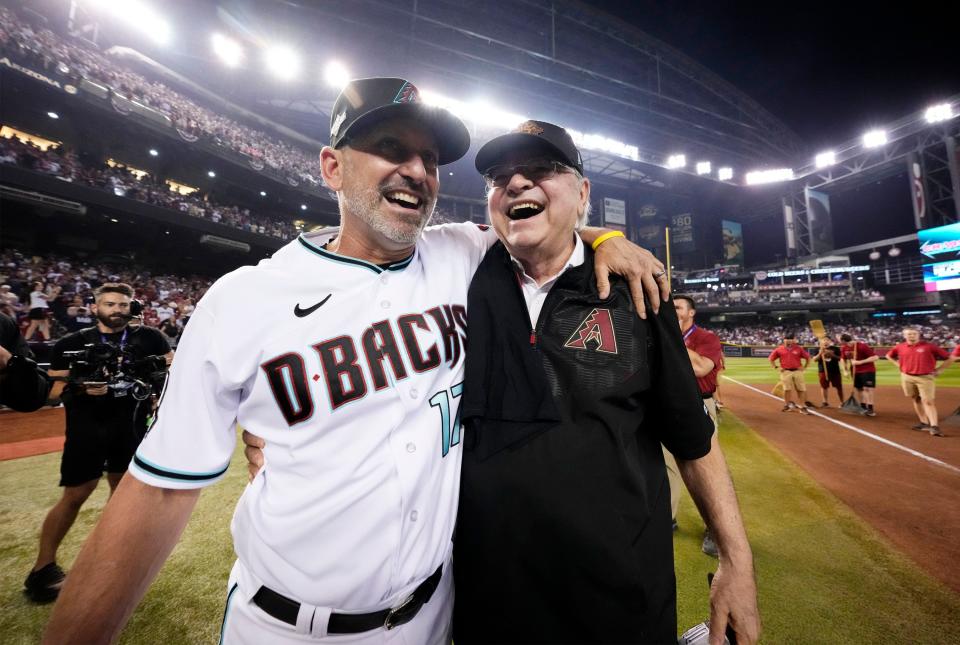The Diamondbacks rekindled Arizona's love for its baseball team. Can they keep it going?

The Diamondbacks handed Arizona an unexpected gift this year. Now they will try to make it one that keeps on giving.
During an October run to the World Series, the Diamondbacks surprised, delighted and roused a fanbase in ways they had not in more than two decades. They captivated the Valley, turning indifference into fandom. They made Phoenix feel like a baseball town again.
They have done this before. They have assembled an exciting core of players, advanced to the postseason and hinted at good times ahead. Each time, they have failed to deliver on that hope.
We will find out in 2024 whether this time will be different.
When the franchise was born in the late 1990s, there was little question baseball would thrive here. Arizona and spring training were synonymous. There were ballfields and sunshine aplenty, and a major-league team would only give snowed-in Midwesterners another reason to help this fast-growing town grow even faster.
At first, it played out as expected. The Diamondbacks were bad in their inaugural season, losing 97 games, but fans packed to witness the spectacle then known as Bank One Ballpark, replete with a retractable roof and a swimming pool.
The club spent lavishly in the ensuing years and built a championship roster filled with star players and household names. Fans kept coming. The Diamondbacks looked like a rousing success of a franchise.
How things turned in the other direction for Arizona
Things quickly went south. The veteran roster got old. Losses accumulated both on the field and in the ledger. Ownership experienced a palace coup. Fans grew weary.
But none of that was insurmountable. Not if the Diamondbacks could build a winner again. But for some 20 years, they could not. Not consistently.
They could not seem to decide how they wanted to operate, could not settle on an identity. They would preach the importance of developing from within, then trade away bushels of prospects in hopes of supercharging a winner. They would talk about fiscal responsibility, then hand out contracts, like the one to Zack Greinke, that did not adhere to those principles.
Give them credit. They were always trying. This was not a franchise keen on tanking. They wanted to win. They just always failed to stick the landing.
Perhaps this time will be different. They again have some things going for them.
Not only do they employ outfielder Corbin Carroll, who is one of the better young players in baseball, they have him signed to a contract that could last another eight years. Carroll’s presence opens a competitive window for the organization; the extension props it open even wider.
Building around Corbin Carroll
The club has other talented young players surrounding him, including catcher Gabriel Moreno, pitcher Brandon Pfaadt and outfielder Alek Thomas. It has more young talent not far behind, including shortstop Jordan Lawlar.
And, of course, it has a strong collection of veterans who can keep contributing right away, such as pitchers Zac Gallen and Merrill Kelly, second baseman Ketel Marte and first baseman Christian Walker.
But perhaps most important is the fact that the organization seems to have a healthy front office/ownership dynamic. They have a talented baseball operations group led by General Manager Mike Hazen. Managing General Partner Ken Kendrick and President Derrick Hall seem to have trust in Hazen and to have grown more patient over the years.
Unlike in previous winters, the club’s moves this offseason seem to have a distinct eye toward the future. After successful seasons in the past, the Diamondbacks traded away young players in order to fortify their big league roster. It was this time of year when the likes of Carlos Gonzalez (in the Dan Haren deal), Adam Eaton (in the Mark Trumbo deal) and Dansby Swanson (in the Shelby Miller deal) were flipped in order to acquire veteran players.
This winter, however, the Diamondbacks’ big moves have mostly involved dollars: They took on salary to acquire slugger Eugenio Suarez, and their big free-agent signings — left-hander Eduardo Rodriguez and Lourdes Gurriel Jr. — cost them only money.
Diamondbacks fans resurfaced in droves in October. They packed Chase Field. They chanted for the Diamondbacks at a Suns game. They gathered in bars and restaurants when the team was on the road.
They also appear eager to see the success continue. A team official said 2024 season-ticket sales have been strong since October, and the season-ticket holder base likely will be north of 10,000 for the first time since the early 2010s.
It is clear the Diamondbacks have before them a rare opportunity to keep the momentum going. They do not need to one-up or even repeat what this year’s team accomplished; getting to the World Series is incredibly difficult. But if they could show that 2023 was not a fluke and that the Diamondbacks as contenders are here to stay — if they could get back to the postseason, say, twice more in the next three years — then perhaps what everyone saw and felt and experienced in October won’t be the anomaly.
Perhaps we will be able to see Phoenix in the same light as before — as a baseball town.
This article originally appeared on Arizona Republic: Diamondbacks have rare opportunity in 2024: Keep the momentum going
